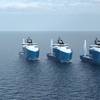U.S. naval forces are poorly equipped to counter a growing mine warfare threat and are about to lose the potentially decisive ability to plant sea minefields of their own, a report for the Navy released on Thursday said.
A committee of the National Research Council cited the "largely unregulated sale" of underwater mines by Italy, Sweden, Russia and other ex-Soviet bloc states as contributing to the danger to U.S. mobility. More than 50 countries now possess a sea mining capability, it said.
"U.S. naval forces are not now likely to be able to adequately handle the plausible near-term threat of mines either offshore or inshore," said the report, prepared at the request of the chief of naval operations, Admiral Vernon Clark.
The United States should boost its mine warfare budget about 30 percent to plug the gap, said the panel established under the auspices of the Naval Studies Board.
The Navy's main suppliers of advanced counter-mine technologies are Lockheed Martin Corp., Boeing Co., Raytheon Corp. and Northrop Grumman Corp.
The spending plan that the Navy identifies with mine warfare, about $4.6 billion over the next seven years, is earmarked almost entirely for countermine warfare, said the report made available in prepublication form, subject to further editing.
It identified a whole host of possible uses for future U.S. minefields, including the defense of Taiwan against any Chinese resort to use of force to unite the self-governing island with the mainland.
Other potentially U.S.-mineable waters include the Persian Gulf, Strait of Hormuz, Red Sea, Adriatic Sea, Yellow Sea, Korea Strait and the coastal margins of the Sea of Japan, the committee said.
"The United States has growing strategic interests in the littoral regions of the world where naval mining could be highly effective," the report said. But it said the U.S. naval mine capability is in "woefully bad shape."
"The decline of the U.S. mining capability is evidenced in the aging and decreasing inventories of mines, the absence of an effective mining capability beyond shallow depths, the termination of all mine acquisition programs, the dramatic decline in development activity at Navy laboratories, the loss of an industrial base and the lack of training and exercises," the report said.
A Navy spokeswoman on mine warfare, Lt. Brauna Carl, said it would be premature to comment on the study until the service received a final copy.
Since 1950, 14 U.S. ships have been sunk or damaged by mines, seven times as many as have been damaged by missile or air attack, the report said. By contrast, no U.S. ships have been damaged by submarine action since WW II.
Even as it urged U.S. development and procurement of more advanced mines, the committee said Washington should push for an international pact to curb the spread of mine technology analogous to the Missile Technology Control Regime instituted in 1987. -- (Reuters)
Featured videos

Inmarsat Enhances Service to Drive Digitalization

Inside the Electrified Truckable Tug

Tracking Foreign Vessels Working in the U.S. Jones Act Market
Subscribe for
Maritime Reporter E-News
Maritime Reporter E-News is the maritime industry's largest circulation and most authoritative ENews Service, delivered to your Email five times per week









